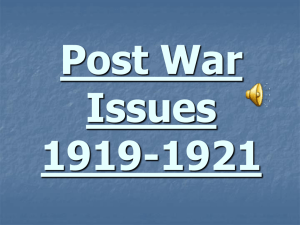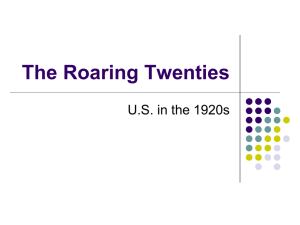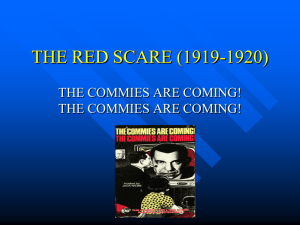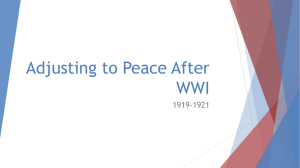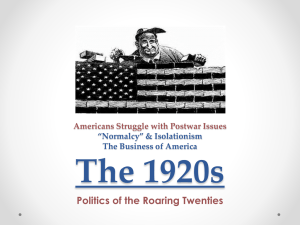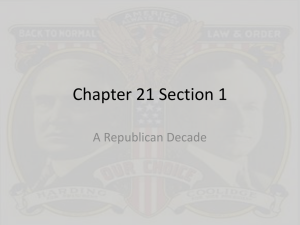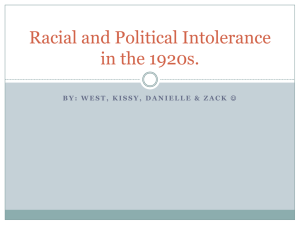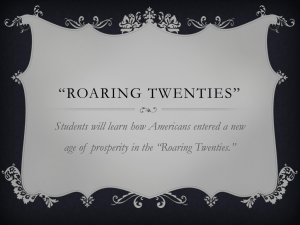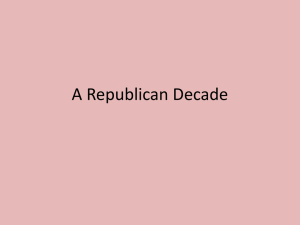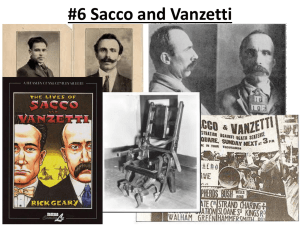What problems are likely to exist after WWI in America?
advertisement
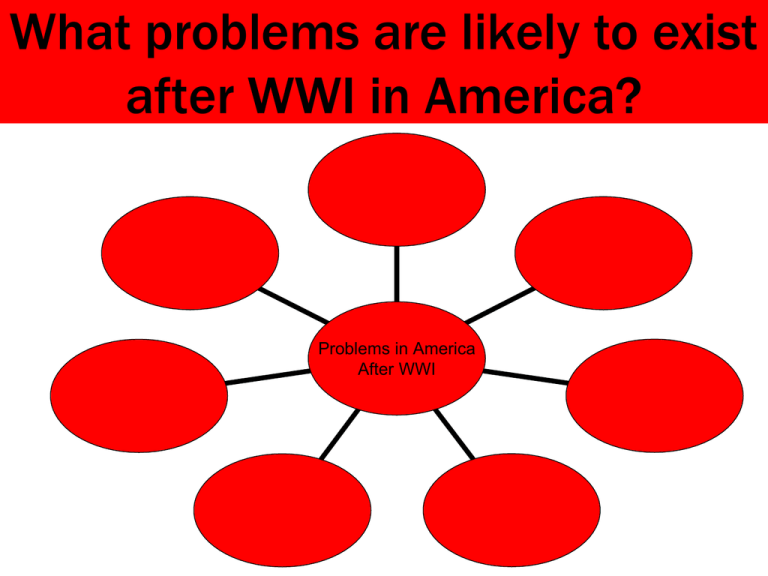
What problems are likely to exist after WWI in America? Problems in America After WWI What problems are likely to exist after WWI in America? Labor Strikes Limit on immigration (Quota System) Unemployment for returning soldiers Problems in America After WWI Rise of KKK Economy (Standard of Living doubled!!) Nativism Red Scare Postwar Issues • During the war, workers’ rights has been limited. • In 1919, workers began to cry out for fair pay and better working conditions. • Tensions arose between labor and management and a rash of labor strikes broke out across the country. • Many Americans were not supportive of striking workers – they wanted to get back to peaceful living (like before the war) and resented anyone who caused unrest. Postwar Trends • WWI had left much of the American public exhausted. • The debate over the League of Nations had deeply divided America. • The economy was in a state of adjustment. • Returning soldiers faced unemployment or took their old jobs away from women and minorities. • The cost of living had doubled! Postwar Trends • A wave of nativism, or prejudice against foreign-born people, swept the nation. • So, too, did a belief of isolationism, a policy of pulling away from involvement in world affairs. Fear of Communism • One perceived threat to American life was the spread of communism, an economic and political system based on a single-party government ruled by a dictatorship. Communism • Communists would put an end to private property, substituting government ownership of factories, railroads, and other businesses. US Coffee and Donuts US Burgers “The Red Scare” • The panic in the United States began in 1919 after revolutionaries in Russia overthrew the czarist government and established a new communist state. • Communists, or “reds,” cried out for a worldwide revolution that would end capitalism everywhere. • A communist party formed in the United States including some 70,000 radicals. • When several dozen bombs were mailed to the government and business leaders, the public grew fearful that the Communists were taking over. First Red Scare • First Red Scare The Palmer Raids • US Attorney General A. Mitchell Palmer took action to combat the “Red Scare.” • Palmer and his agents hunted down suspected communists, socialists, and anarchists – people who opposed any form of government. – They trampled people’s civil rights, invading private homes and offices, and jailing suspects without allowing them legal counsel. – Hundreds of foreign-born radicals were deported without trials. The Palmer Raids •Palmer’s raids failed to turn up evidence of a revolutionary conspiracy, or even explosives. • Many thought Palmer was just looking for a campaign issue to gain support for his presidential aspirations. • Soon, the public decided that Palmer didn’t know what he was talking about. Palmer Raids • Palmer Raids The Red Scare Read “Red Scare” Then, summarize what happens during this time period. Tell your partner… Were the Palmer Raids successful? Why or why not? Sacco and Vanzetti •Although short-lived, the Red Scare fed people’s suspicions of foreigners and immigrants. • The two most famous victims of this attitude were Nicola Sacco and Bartolomeo Vanzetti, a shoemaker and fish peddler. • Both were Italian immigrants and anarchists. Sacco and Vanzetti • In May 1920, Sacco and Vanzetti were arrested and charged with the robbery and murder of a factory paymaster and his guard in Massachusetts. • Witnesses had said the criminals appeared to be Italians. • The accused asserted their innocence and provided alibis. Sacco and Vanzetti • The evidence against them was circumstantial and the presiding judge made prejudice remarks. • Nevertheless, the jury still found them guilty and sentenced them to death. •Many people thought Sacco and Vanzetti were mistreated because of their radical beliefs while others felt it was because they were immigrants. •The two men died in the electric chair on August 23, 1927. Sacco and Vanzetti • Sacco and Vanzetti • Read “Poor but Never Hungry” Tell your partner… Was the Sacco and Vanzetti trial fair? Limiting Immigration • Anti-immigrant attitudes had been growing in the United States ever since the 1880s when new immigrants began arriving from Southern and Eastern Europe. • Many of these immigrants were willing to work for lower wages in industries such as coal mining, steel production, and textiles. Limiting Immigration •But after WWI, the need for unskilled labor in the US decreased. • Nativists believed that because the US had fewer unskilled jobs available, fewer immigrants should be let into the country. Tell your partner… Does this sound familiar? The Klan Rises Again • As a result of the Red Scare and antiimmigrant feelings, different groups of bigots, or people who were intolerant of any creed, race, religion, or political belief that differs from their own, used anti-communism as an excuse to harass any group unlike themselves. • One such group was the Ku Klux Klan (KKK). • The Klan believed in keeping blacks “in their place” destroying saloons, opposing unions, and driving Roman Catholics, Jews, and foreign-born people out of the country. The Quota System • From 1919-1921, the number of immigrants had grown almost 600% from 141,000 to 805,000 people. • Congress, in response to nativist pressure, decided to limit immigration from certain countries, mostly those in Southern and Eastern Europe. • The Emergency Quota Act (1921) set up a quota system. – This system established the maximum number of people who could enter the US from each foreign country. – The goal was to cut sharply European immigration to the United States. Which problem do you believe was the most important to address? Why? Labor Strikes Limit on immigration (Quota System) Unemployment for returning soldiers Problems in America After WWI Rise of KKK Economy (Standard of Living doubled!!) Nativism Red Scare Homework: •You are to draw a picture of one of the following topics: – Communism – Anarchist – Red Scare – Nativism – Ku Klux Klan – Quota System • Must be colored! • Must include a paragraph description on the back!

